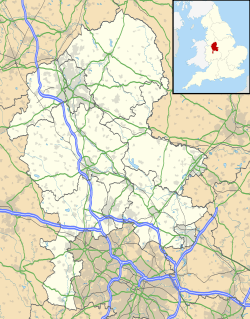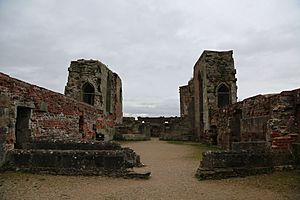Stafford Castle facts for kids
Quick facts for kids Stafford Castle |
|
|---|---|
| Staffordshire, England | |

Stafford Castle
|
|
| Coordinates | 52°47′50″N 2°08′48″W / 52.7973°N 2.1468°W |
| Grid reference | grid reference SJ902222 |
| Type | Motte and bailey, later Gothic Revival |
Stafford Castle is an old castle located about two miles west of Stafford in Staffordshire, England. It's a Grade II listed building, which means it's an important historical site that is protected.
Since the Norman Conquest in 1066, this castle was the home of the powerful Stafford family. They were important nobles who became Barons, Earls, and even Dukes. The main stone tower, called a keep, was pulled down in 1643 during the English Civil War. Lady Isabel Stafford, who supported the King, had been defending it.
In the early 1800s, the Jerningham family rebuilt parts of the castle. They used a style called Gothic Revival, building on the old foundations and using many of the original stones. Today, the A518 road passes right by it. The castle is easy to spot from the M6 motorway and the main West Coast train line.
Contents
History of Stafford Castle
Early Beginnings: A Saxon Fort
An old historian named Robert Plot wrote about Stafford Castle. He said that Æthelflæd, a Saxon princess and ruler, built a castle in Stafford in 913. She also built a fortified town, called a 'burg', next to it. We don't know exactly where this first castle was, but it was probably made of wood.
Medieval Times: From Wood to Stone
Saxon Defeat
Before the Normans built their castle, a Saxon leader named Eadric the Wild led a rebellion. The Saxons were defeated at the Battle of Stafford in 1069.
Norman Construction
Around the 1070s, a wooden castle was built here by a Norman lord. His name was Robert de Stafford, also known as Robert de Tosny. He came to England during or after the Norman Conquest of 1066. King William the Conqueror gave him many lands, mostly in Staffordshire. This helped him control the area and collect taxes. It also helped prepare for the Norman invasion of Wales in 1081.
The first castle was a motte and bailey. This means it had a large mound (the motte) with a tower on top. Below it was a walled courtyard (the bailey).
Later, in 1347, Ralph de Stafford, 1st Earl of Stafford, decided to build a stone castle. He was a leading commander for the King during the Hundred Years' War. The stone keep was rectangular and first had a tower at each corner. Later, a fifth tower was added to the middle of the north wall.
Later Years: Decline and Rebuilding
The stone castle was at its grandest during the time of Humphrey Stafford, 1st Duke of Buckingham. He was killed in 1460 at the Battle of Northampton. His grandson, Henry Stafford, 2nd Duke of Buckingham, supported King Richard III at first. But then he rebelled to help Henry Tudor (who became King Henry VII). Henry Stafford was executed in 1483 for this.
His son, Edward Stafford, 3rd Duke of Buckingham, managed to escape. King Henry VII later gave him back his family's lands. In 1511, the 3rd Duke built another grand home, Thornbury Castle. But his royal connections made him a threat to King Henry VIII. The King had him executed in 1521. Stafford Castle and its lands then went to the Crown.
Stafford Castle was later returned to the Stafford family. However, they never got back their old wealth or importance. The castle keep slowly fell apart. In 1603, Edward Stafford, 3rd Baron Stafford called it "My rotten castle of Stafford."
The English Civil War
During the English Civil War in 1643, Lady Isabel Stafford held the castle. She was a strong supporter of the King. The Parliamentarians captured the town of Stafford in May 1643. Some of their soldiers escaped and held the castle. They hoped to use it to take back the town.
Colonel William Brereton rode to the castle and asked Lady Stafford to give up. She refused. The Parliamentarians then set fire to some of the smaller buildings around the castle. Lady Stafford still would not surrender. The siege was stopped when Colonel Hastings arrived with more soldiers.
Lady Stafford was eventually convinced to leave. A small group of soldiers stayed to defend the castle. But in late June, they heard a large Parliamentarian army was coming with powerful cannons. The Royalist soldiers fled. The castle then fell to the Parliamentarians. On December 22, 1643, they ordered the castle to be pulled down. When Celia Fiennes visited Stafford in 1698, she saw only "the fortified trenches that are grown over green."
Re-emergence: A New Look
By the 1790s, only a small part of one wall could be seen above ground. Workers trying to fix this wall found the buried castle basements and foundations. They told Sir William Jerningham about their discovery. He ordered all the old foundations to be uncovered and the area cleared.
The castle was partly rebuilt starting in 1813 in the Gothic Revival style. This work stopped because of a lack of money. Also, the Jerningham family became nobles, which was one reason they wanted to restore the castle. Some people called the rebuilt castle a 'folly' (a building built just for decoration). But it was always meant to be lived in and was used as a home well into the 1900s.
Modern Times: A Public Landmark
After World War II, the trees around the castle keep were cut down. This might have exposed the building to strong winds. By 1949, large pieces of stone began to fall from the towers, making them unsafe. The last caretakers left the castle that winter. The site was damaged by vandals. In 1961, Lord Stafford gave the keep to the local government.
In 1978, professional digging began to explore the castle's history. This site had been home to one of the most important families in the area for many years. The digging continued for a long time. It even helped many young people find jobs during the tough economic times of the early 1980s. The BBC documented these excavations and the creation of a reconstructed medieval herb garden.
In 1988, the castle officially opened to the public. A heritage trail was created with signs and information. New fences were put up along improved paths. In 1992, a new museum and a gift shop opened below the castle mound.
See also
 In Spanish: Castillo de Stafford para niños
In Spanish: Castillo de Stafford para niños
- Castles in Great Britain and Ireland
- List of castles in England
- Listed buildings in Stafford (Outer Area)



